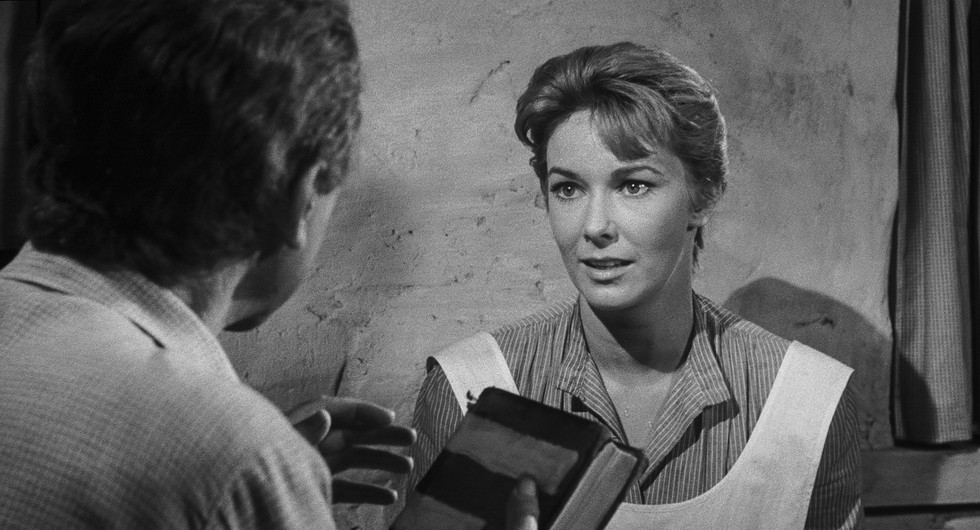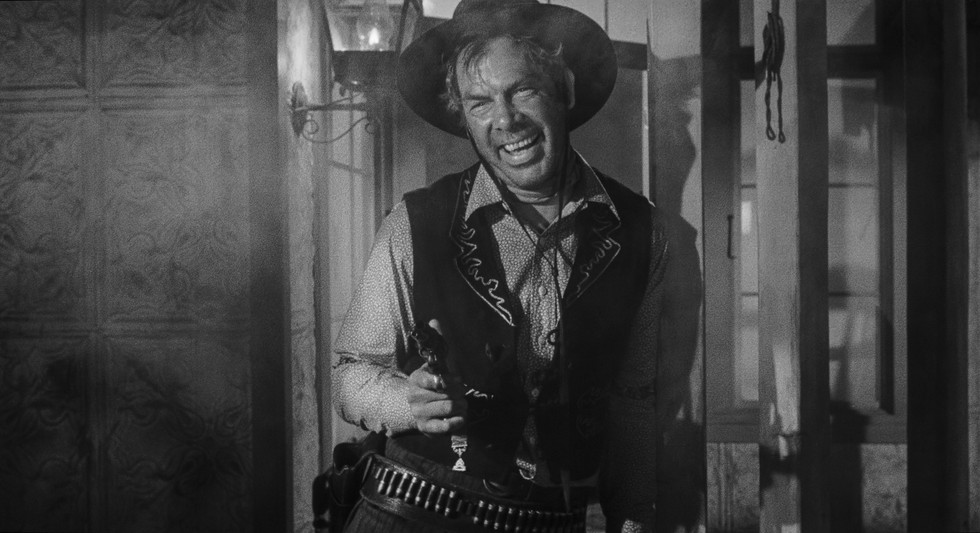Ford’s classic Western “The Man Who Shot Liberty Valance” nearly derails on 4K Ultra HD
- Bill Kelley III
- May 7, 2022
- 8 min read
Updated: May 11, 2022
4K ULTRA HD REVIEW / HDR FRAME SHOTS

Lee Marvin stars as savage killer Liberty Valance and John Wayne as the ruff cowboy Tom Doniphon.
(Click an image to scroll the larger versions)

“THE MAN WHO SHOT LIBERTY VALANCE” – PARAMOUNT PRESENTS
4K Ultra HD, Blu-ray, digital copy; 1962; unrated; Streaming via Amazon Prime Video, Apple TV (4K), Vudu (4K), YouTube
Best extra: The seven-part featurette “The Size of Legends, The Soul of Myth”
BETTER late than never. Paramount Home Entertainment has finally released a John Ford classic in 4K Ultra HD disc format in the admirable Paramount Presents Series.
Two years ago, one of their first titles was Hitchcock’s “To Catch a Thief” (1955) No. 3 in the series. It received mixed reviews because of some digital noise reduction. Then “King Creole” (1958), No. 2 starring Elvis Presley, came out in a 4K digital release showing no signs of DNR.
Now, all titles in Paramount's series are mastered in the highly desired 4K resolution from original 35mm camera negatives or best surviving elements. Sadly, the physical discs were only in 1080p, leaving the clarity of millions of pixels from the screen. Paramount enclosed digital codes, which in most cases transferred to a 4K digital version on Apple TV or iTunes. Statistically, we know discs produce a much higher bitrate for video and audio than streaming, which makes Paramount’s new 4K disc release a more pleasing experience.
To celebrate the 60th anniversary of John Ford’s last great western, “The Man Who Shot Liberty Valance,” Paramount selected the film as No. 31 in the series and made it the first 4K Ultra HD/Blu-ray combo disc set. Earlier this year, the 4K digital version was made available, but without extras.
(1) “The Man Who Shot Liberty Valance” opened in New York City on May 23, 1962. (2) A Virginia & Truckee 4-4-0 No. 22 “Inyo,” an 1875 product of Baldwin Locomotive Works, was owned by Paramount Studios. (3&4) Retired Marsal Link Appleyard (Andy Devine) greets U.S. Senator Ransom Stoddard (James Stewart) and his wife, Hallie (Vera Miles), at the Shinbone train station.
Close-ups expose digital noise reduction to the 4K version
Left - DNR on the 4K Ultra HD version caused unnatural and uneven film grain in the sky, hat, and face, plus a softer image on this exterior scene.
Right - The 1080p Blu-ray with more natural film grain from top to bottom.
Another shot with film grain reduction

Left - DNR applied on the 4K Ultra HD version caused unnatural and uneven film grain on this exterior scene.
Right - The 1080p Blu-ray with more natural film grain from top to bottom.
More film grain reduction

(top) 4K frame shot of Stoddard getting a shooting lesson from Doniphon. (middle) A tight crop from the 4K disc, with an odd film grain/pixel structure in the sky and on Stewart’s face. (bottom) A tight crop from the 1080p disc, with a normal film grain structure.
Ford assembled an all-star cast featuring his company of stock actors: Andy Devine, John Carradine, Jeanette Nolan, John Qualen, plus Vera Miles, Lee Marvin, Edmond O’Brien, and Woody Strode. Also, for the first time together, John Wayne (Cowboy/Rancher Tom Doniphon) and James Stewart (Lawyer/Senator Ransom Stoddard). The two actors flipped a coin to decide who got top billing. Wayne won for the screen, Stewart for advertising.
Film historian and director Peter Bogdanovich (“The Last Picture Show,” “Paper Moon”), who recently passed away, believes the film is Ford’s “most provocative, poetic drama of American political conflict.” Based on a Dorothy M. Johnson short story, he says “It’s arguably the film that marked the end of Hollywood’s golden age.”
“Liberty Valance” is an atypical Ford Western. Filmed on Paramount soundstages in black-and-white, Wayne is the central character, even though Stewart gets the most screen time. Both actors were in their mid-50s playing much younger men. They’re clearly too old, but it’s Wayne and Stewart, “So you go with it,” Bogdanovich says.
Told through flashback, the story is an “eternal triangle” of two men and a woman. Wayne (Tom Doniphon) is cast as his standard rough cowboy who gives the love interest – Hallie played by Vera Miles – a cactus rose. Stewart is the idealistic Eastern lawyer, who Doniphon saves from a savage beating by Liberty Valance (Lee Marvin). “[Valance is] a no-good, gun-packing, murdering thief,” Stoddard says. Doniphon suggests the lawyer should pack a handgun because Valance is the “toughest man south of the Picketwire.” Stoddard snaps back, “I don’t want to kill him, I want to put him in jail.”
Natural film grain reappears
(1&2) Link Appleyard takes Hallie Stoddard to Tom Doniphon’s burned-out cottage where the cactus roses are blooming. (3) Ransom and Hallie pay their respects to Tom Doniphon. (4) Old cowboy Pompey is heartbroken with the death of Doniphon.
The opening sequence follows a train as it arrives in the small town of Shinbone. U.S. A. Now a senator, Stoddard, and his wife step off, and a reporter questions their unannounced arrival. They’ve returned to attend Doniphon's pauper’s funeral. Told from two points of view, the story concludes with a big showdown between Stoddard and Valance.
In his “Great Movies” book, film critic Roger Ebert writes that he felt “Liberty Valance” had strong, underlying themes. “This is fascism against democracy: the tyranny of the strongman over the ordinary people. Everyone in Shinbone hates Liberty Valance, but they’re powerless against him and his two sidekicks.”
FOOTNOTE: The famous phrase “Pilgram” that impressionist Rich Little used for Wayne came from this western. Doniphon uses it 23 times while addressing Stoddard. Famous Italian director Sergio Leone (“The Good, The Bad and the Ugly,” “Once Upon a Time in the West”) considered “Liberty Valance” his favorite Ford film.
EXTRAS
The new “Filmmaker Focus” featurette, with film critic/historian Leonard Maltin, provides a short overview of Ford’s legacy and “Liberty Valance.” He says Ford is the only filmmaker in Academy Award history to win four Best Director Oscars. “His films were not art films, although they were artistic,” he says. Ford’s best work included “The Grapes of Wrath” (1940) Oscar for Best Director, “How Green Was My Valley” (1941) Winner for Best Picture and Best Director, “Stagecoach” (1939) Ford’s first western with Wayne, “Young Mr. Lincoln,” (1939), “The Informer” (1935) Best Director, “The Quiet Man” (1952) Best Director and “The Searchers” (1956). Ford’s eldest son Michael tells Maltin that his dad, “was a great director between ‘action’ and ‘cut.’” Beyond that, he was “an absolutely quixotic, cantankerous, sometimes outright mean-spirited guy. And, was especially nasty to his protégé, John Wayne.”
FLASHBACK (1&2) Liberty Valance and his gang attack a stagecoach heading toward the small town of Shinbone. (3) Young attorney Ransom Stoddard lashes out toward Valance after he attacked an older lady. (4) Valance severely beats Stoddard with a whip. (5) Doniphon and Pompey bring Stoddard to the Ericson diner where Hallie attends to the injured Stoddard.
A series of 1970s audio recordings are provided by Ford’s grandson Dan, who interviewed his grandfather and actor Lee Marvin.
The best bonus is the 2009 seven-part featurette “The Size of Legends, The Soul of Myth.” It includes interviews from film critics, producers, and family members, Ford biographer Scott Eyman and Bogdanovich, who describe the making of “Liberty Valance.” They give context to the early ‘60s when the Hollywood studio system was dying and independent filmmaking was taking over. It was difficult for Ford. “The world he knew was collapsing,” Bogdanovich says. Ford and his writers ended up changing the Doniphon character from the “kind of fairy godfather” of the short story, nudging Stoddard into two acts that alter his life. “And that’s enough,” Eyman says.
At the time, Wayne was in a 10-picture deal with Paramount that ran throughout the ‘60s. Studio producer A.C. Lyles was constantly asked why they invested so much in an aging Wayne. “It’s called money,” Lyles said. “Duke Wayne pictures were acceptable all over the world.” But six months of delays nearly collapsed production. Star salaries and rising overhead were concerns, as well as Ford’s periodic alcoholic binges which plagued his career for over 40 years.
The production began on Paramount soundstages, with the opening train scene filmed at MGM’s lot No. 3. It was “very claustrophobic, and the few exteriors are not beautiful,” Bogdanovich says. “It doesn’t have the air and grandeur of the Ford pictures we’re used to.” Ford said, “I did all that. That’s not what this is about.”
(1) Tom Doniphon after rescuing Stoddard. (2) The town drunks: newspaper editor Dutton Peabody (Edmond O’Brien), Marshal Appleyard, and Doc Willoughby (Ken Murray). (3&4) Stoddard tells Hallie he'll teach her how to read. (5&6) The reading class included children and adults.
Ford’s style was very economic, with few takes; he only shot what he needed. He insisted the film be captured in black-and-white, because of one sequence - the scene when we find out “who really shot Liberty Valance,” Eyman says. “This is a somber movie and the black-and-white reflects it,” says film critic Molly Haskell. Plus, the heavy old-age makeup used by Stewart and Miles would’ve looked artificial in color.
Strangely, the commentary with Bogdanovich in which he plays excerpts from his ‘66 recordings with Ford and with Stewart, is only featured on the enclosed Blu-ray. He recounts his first viewing during an early screening in New York. “I was enormously moved by it, but by that point, I had seen virtually everything Ford had made. This is his penultimate Western.” He mentions the criticism the film received. “[Ford's] Westerns took a real downward trajectory, not in terms of quality, but in terms of the optimism of ‘Wagon Master’ from 1950 and down to the tragic overtones of this film. In fact, it’s a tragedy.”
VIDEO
Paramount provided no details about whether the original black-and-white camera negative by cinematographer William Clothier or a second-generation print or negative was used. Even so, the source or sources were scanned and mastered in 4K (1.85:1 aspect ratio). “Meticulously remastered in stunning 4K,” Paramount claims in its press release.
Those aren’t the words I'd use. It’s a roller coaster combination of digital noise reduction and natural film grain. From start to finish, the 1080p disc shows consistent film grain in the 4K master from highlights to mid-tones and shadows. Both discs are super clean with no marks and scratches.
But whoever was at the controls for the 4K Ultra HD mastering must have lost their way. The film grain is up and down with blocks of DNR applied, most apparent during the film’s few daylight scenes. Film grain nearly disappears during some highlights and mid-tones. It’s most obvious when Stoddard gets a shooting lesson from Doniphon. Filmed at the Janss Conejo Ranch in Ventura County near Los Angeles, the grain in the sky nearly vanishes, and sometimes on Wayne and Stewart’s faces, causing odd-shaped digital blocking.
(1&2) Valance jokes Stoddard for being a waitress at the Ericson diner. (3) Pompey pulls a shotgun to make sure Valance doesn’t start a violent attack. (4) Stoddard visits the newspaper office and reads the latest Shinbone Star headline: “Cattleman Fight Statehood.” (5) The town folks nominate Stoddard to be a delegate to the territorial convention.
Nighttime scenes and interiors make up the majority of the film, and show favorable and consistent grain. Most studios apply some amount of film grain reduction in 4K titles, while Sony, Arrow Video and MGM/UA masters for Kino keep the grain natural and intact.
Overall sharpness and clarity are slightly better on the 4K disc in costume textures and patterns and object edges. HDR10 and Dolby Vision (disc & digital) toning is darker – especially mid-tones, while the grayscale is more balanced.
AUDIO
The original 2.0 mono track has been restored removing pops and hiss, and a six-channel DTS-HD soundtrack has been created. Still, I prefer the mono track with its straightforward dialogue-driven story.
FINAL VERDICT: We appreciate having a 4K disc from the Paramount Present series – especially this Western classic. But, the 4K mastering technician needs to spend some time at Sony’s post-production house to learn the art of film grain, keeping it ALL NATURAL!
— Bill Kelley III, High-Def Watch producer
(1) Liberty Valance nearly kills newspaper editor Dutton Peabody. (2-4) Valance plays a final round of poker before the big showdown between himself and Stoddard. (5) Hallie comforts Ransom after the shootout.








































































